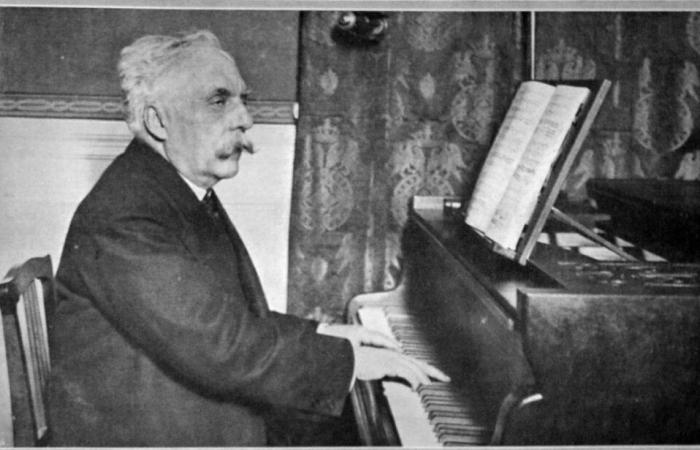What do the large Madeleine church in Paris, enthroned at the end of Rue Royale, and the small town of Pamiers, nestled in the hollow of the Ariège plain? Gabriel Fauré (1845-1924) of course! Next week, two concerts will be held there to pay tribute to one of the most important composers in the history of French music, who died on November 4, 1924, exactly a century ago. Pamiers, Fauré’s hometown, and La Madeleine, where he held the position of organist for so many years, are two places of emblematic life, in the heart of a 19the very French century. A look back at this life of music, in four symbolic works which will resonate throughout the country next week, among many others.
“The Requiem”: the organ hit
In 1887, Gabriel Fauré was chapel master at the Madeleine church in Paris. A vocation born in his childhood in Ariège, when he came to play on the harmonium installed in the small chapel adjoining his school. The son of a teacher, Gabriel nevertheless learned the organ and choir conducting at the Niedermeyer school in Paris, specializing in sacred music.
There, he cultivated all the ingredients to write, at the height of his career, the score which established him as one of the most performed French composers in the world: his Requiem. A work which today accompanies the public funerals of many personalities, from Jacques Chirac to Johnny Hallyday.
Cathedra celebrates the Gabriel Fauré centenary in Bordeaux
Gabriel Fauré died a hundred years ago, almost to the day. To celebrate this anniversary, Cathedra devotes one of its last concerts of the season to its famous Requiem, sung by a professional choir around Alexis Duffaure
“The Elegy” for piano and cello: disappointed love
A young man from the provinces, sent to Paris at the age of 9 by his parents to cultivate his talent, Gabriel Fauré struggled for a long time to break into the musical world, as well as Parisian society. In 1877, he was engaged to the daughter of Pauline Viardot, one of the most prominent musicians of the time.
Without the reasons being known, Marianne Viardot put an end to this relationship, plunging Gabriel Fauré into a long depression coupled with a feeling of deep rejection. From this period of absolute doubt, few scores have come down to us, Fauré destroying most of what he produced then, except “L’Élégie” for piano and cello, with its dark and heartbreaking theme which seems to crystallize all the demons inhabiting its author. This is perhaps what made this score so successful, most often played today in its form for cello and orchestra.
“La Pavane”: portrait of a good fairy
“Madame my fairy”, this is how Fauré called Countess Greffulhe, the benefactress who allowed him to get out of this bad situation, and to finally make his entry into the big leagues. At the end of the century, still very marked by a good society inherited from the Second Empire, having an influential aristocrat to introduce you to major institutions and finance your compositions works more than a diploma.
To thank his patron for her precious help, Fauré dedicated to her a score written for the theater, of which he offered her the manuscript. Success rears its ugly head, and the young man from the provinces begins to make a name for himself in Paris.
Masques and Bergamasques: the Opera at 75
In 1905, there was recognition: Fauré was appointed director of the Paris Conservatory, after having taught composition there and crossing paths with some well-known students such as Georges Enesco, Nadia Boulanger and Maurice Ravel. Curiously, this was not the most prolific period of his life, Fauré being gradually handicapped by incipient deafness.
However, he still has one last stroke of brilliance to offer, with the entry into the repertoire of the Opéra-Comique (the theater which created “Carmen”, in 1875) of “Masques et Bergamasques”, incidental music for orchestra where we hear the modernity of a man who has never let himself be overtaken by his time.
Between the great French tradition of the 19the and the breath of fresh air of the 20th centuryebetween secular poetry and sacred music, between bourgeois salons and popular fervor, Gabriel Fauré is a bridge. One foot firmly anchored on each bank, his music resists time and speaks to the generations who, a century after his death, continue to play it, as if it had always been there.
Where to listen to Fauré’s music?
Television. On Arte, Sunday November 3, at 6:40 p.m.: The Requiem, at the Pantheon.
Paris. Théâtre des Champs-Élysées, Sunday November 3, at 5 p.m.: Fauré evening in three parts. At the Philharmonie de Paris, Wednesday November 6: “Requiem”, by the Orchester de Paris.
Pamiers. (09) Jeu du Mail, Friday November 8: Fauré recital by Jean-Philippe Collard, piano.






